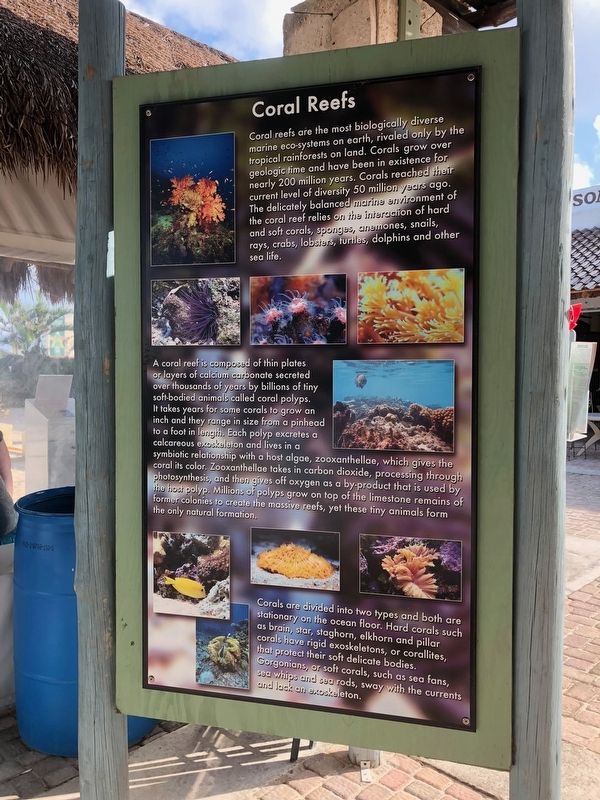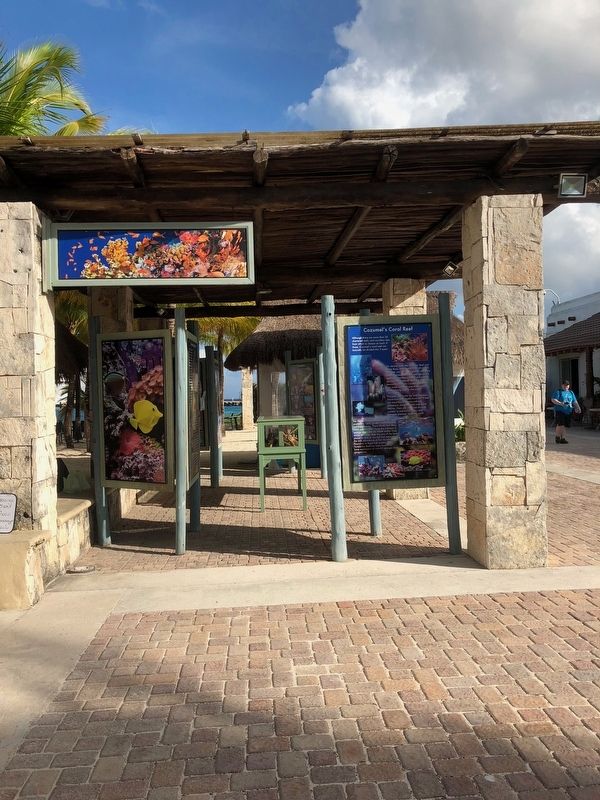Coral Reefs
Coral Reefs are the most biologically diverse marine eco-system on earth rivaled only by the tropical rainforests on land. Corals grow over geologic time and have been in existence for nearly 200 million years. Corals reached their current level of diversity 50 million years ago. The delicately balanced marine environment of the coral reefs relies on the interaction of hard and soft corals, sponges, anemones, snails, rays, crabs, lobsters, turtles, dolphins and other sea life.
A coral reef is composed of thin plates or layers of calcium carbonate secreted over thousands of years by billions of tiny soft-bodied animals called coral polyps. It takes years for some corals to grow an inch and they range in size from a pinhead to a foot in length. Each polyp secretes a calcareous exoskeleton and lives in a symbiotic relationship with a host alga, zooxanthellae, which gives the coral its color. Zooxanthellae takes in carbon dioxide, processing through photosynthesis, and then gives off oxygen as a by-product that is used by the host polyp. Millions of polyps grow on top of the limestone remains of former colonies to create the massive reefs, yet these tiny animals form the only natural formation.
Corals are divided into two types and both are stationary on the ocean floor. Hard corals such as the brain, star, staghorn, elkhorn,
and pillar corals have rigid exoskeletons, or corallites, that protect their soft delicate bodies. Gorgonians, or soft corals, such as sea fans, sea whips, and sea rods, sway with the currents and lack an exoskeleton.Topics. This historical marker is listed in these topic lists: Animals • Environment.
Location. 20° 28.542′ N, 86° 58.506′ W. Marker is in San Miguel de Cozumel, Quintana Roo. Marker is on Avenida Rafael E. Melgar. Marker is near Mayan Fiesta Rum & Cake Company on site of the cruise ship port. Touch for map. Marker is in this post office area: San Miguel de Cozumel QR 77500, Mexico. Touch for directions.
Other nearby markers. At least 8 other markers are within walking distance of this marker. Diosa Ixchel / Goddess Ixchel (a few steps from this marker); Ancient Heritage (within shouting distance of this marker); Chac mool (within shouting distance of this marker); Calendario maya / Mayan calendar (within shouting distance of this marker); Los Sacerdotes Mayas / The Mayan Priests (within shouting distance of this marker); Land of Chocolate (within shouting distance of this marker); Chac-Mool (about 90 meters away, measured in a direct line); Tzolkin (approx. 0.3 kilometers away). Touch for a list and map of all markers in San Miguel de Cozumel.
Also see . . .
1. Coral reef. Coral reefs are diverse underwater ecosystems held together by calcium carbonate structures secreted by corals. Coral reefs are built by colonies of tiny animals found in marine water that contain few nutrients. Most coral reefs are built from stony corals, which in turn consist of polyps that cluster in groups (Submitted on February 7, 2018, by Sandra Hughes Tidwell of Killen, Alabama, USA.)
2. Zooxanthellae. Zooxanthellae are single-celled dinoflagellates that are able to live in symbiosis with marine invertebrates such as corals, jellyfish, and sea anemones. (Submitted on February 7, 2018, by Sandra Hughes Tidwell of Killen, Alabama, USA.)
3. Gorgonian. Alcyonacea is an order of sessile colonial cnidarians found throughout the oceans of the world, especially in the tropics and subtropics. The name "Gorgonacea" is no longer considered valid and Alcyonacea is now the accepted name for the order. Gorgonians are also known as sea fans and sea whips and are similar to the sea pen, a soft coral. Gorgonians are closely related to coral. (Submitted on February 7, 2018, by Sandra Hughes Tidwell of Killen, Alabama, USA.)
Credits. This page was last revised on December 13, 2020. It was originally submitted on February 7, 2018, by Sandra Hughes Tidwell of Killen, Alabama, USA. This page has been viewed 131 times since then and 3 times this year. Photos: 1, 2. submitted on February 7, 2018, by Sandra Hughes Tidwell of Killen, Alabama, USA. • Andrew Ruppenstein was the editor who published this page.

